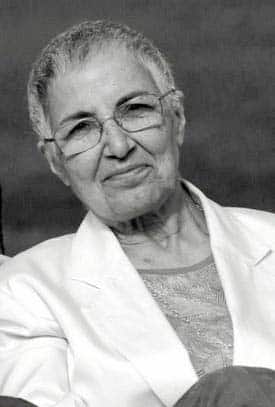by the Editors

When On The Issues Magazine decided to pursue Passion, Freedom, Women and the topic of women fighting for freedom around the world despite the risks to themselves, we discussed several big questions.
What drives the people who are willing to put their lives at peril for the greater good? What separates them from those who don’t? What is a martyr? What is a freedom fighter?
As we have often done in the past, we turned to Dr. Mahin Hassibi to help us find the answers. Mahin always brought tenacious wisdom, visionary insight and critical thinking to complex topics, managing to knit together history, psychology, sociology, theology, philosophy and anthropology with fresh and original analysis. Some of her writings have generated the highest hits of our Online publication, such as Busting Bogus Biology and Beliefs in the Summer 2009 edition of On The Issues Magazine, which dissects old notions of the “gender binary.”
In late 2009, she began looking at this topic, too. Unfortunately, cancer overtook Mahin before she could complete her work – she was probing the nature of martyrdom through history and how it related to women who are fighting for freedom. Nonetheless, before she died, she preserved some of her thoughts in an email, and we share them here, along with a look at her many other contributions of multidimensional commentary and independent thinking.
Losing A Friend and Sage
Dr. Mahin Hassibi died on January 20, 2010 at Sloan Kettering Memorial Hospital, surrounded by loving friends and family after a one year struggle with cancer. She was 72. In her work and her life, Mahin was wise, courageous and compassionate — a powerful force of love and a fierce advocate for children’s mental health, as well as a visionary thinker.

Dr. Mahin Hassibi, OTI publisher Merle Hoffman, and Kate Millett
Hassibi’s career included appointments as a Professor of Clinical Psychiatry at New York Medical College; Associate Professor of Clinical Psychiatry at New York University; Assistant Chief of Child Psychiatry Metropolitan Hospital; and Medical Director of Choices Mental Health Center. She was also a Contributing Editor to On the Issues Magazine, both in its print and Online versions.
Dr. Hassibi was the co-author with Stella Chess and Harry Breuer of Disordered Thinking and Communication in Children in 1980, and was co-author of Principles and Practice of Child Psychiatry with Stella Chess in 1978.
She also authored numerous journal articles. Her groundbreaking pieces in On The Issues Magazine included Sexual Apartheid in Iran; Why Change the World….When You Can Have a Prozac Moment?” and Ending the Male Patina in Biology.
Readers and others are invited to share their thoughts about Mahin or read those submitted at the New York Times “Guestbook.”
Contributing to the Bigger Picture
As noted, Mahin Hassibi was a frequent and welcome contributor to On The Issues Magazine. Some of her work is included below.
On the topic of Passion, Freedom, Women, Mahin Hassibi had begun to look at the nature of martyrdom throughout history. Our questions: What is the meaning of martyrdom? Are the women who put their lives at peril to fight for freedom “martyrs”? What does it mean to be a “martyr” to a cause?
“On Martyrdom: Some Thoughts”
Over the centuries, martyrdom has had a religious connotation and the theological interpretation of martyrdom in all major religions has changed very little. The goal and meaning of martyrdom has been universally conceptualized as a sacred act, attesting and bearing witness to a belief in the perfection of God’s design for the universe. Believers maintain the willingness — even the obligation — to serve as the warrior of God, even at the cost of their own lives.

As such, men and women can volunteer or be called to martyrdom by religious authority. They may actively seek martyrdom or passively accept it as their destiny. Through history, popes and khalifs have summoned, encouraged and even threatened the faithful to join armies and fight battles in the name of their religion.
What has received less attention is the human aspect of martyrdom. Martyrs, by their acts, assert the freedom of conscience in the face of overwhelming power against their powerlessness. It is on this battleground that the exercise of might fails to achieve its goal of humiliation and conquest. The martyr is aware of the ability to use his or her own life as the ultimate weapon and overcome the biological reluctance of the body to self-destruction, presenting unique rewards, regardless of what has been promised in the afterlife.
The separation of martyrdom from its old theological basis enables other ideologies and viewpoints to secure equal importance to religion as a motivating impulse. So there are martyrs to various causes, and those fighting for freedom summon the singular ability to put their whole beings – intellectual, emotional, physical – into the service of a greater good.
Mahin Hassibi
January 2010
Busting Bogus Biology and Beliefs
The feminist movement began to raise questions about the cultural root of male supremacy The simplified male-female concept of “gender” has never been simple. Unrelated to individual capabilities, “gender roles” throughout most of human history have subordinated the female to the male. In more recent years, reexaminations of “gender identity” along with developments in science and society have resulted in new understandings about what gender means to individuals. These developments, in turn, may reshape “gender roles.”
The binary categorization of gender as male-female is based on observed external male and female sexual characteristics.
But the binary categorization has very little to do with gender roles and the universal subordination of women to men. The subordination appears to derive from the difference in physical power of men and women. This was, of course, desirable for men, as well.…
Mahin Hassibi
Summer 2009
Ending the Male Patina in Biology
For the past century and a half, every new discovery of biology has left intact, and even crystallized, the myth of women’s inferiority. Now, galloping developments in biotechnology may alter this age-old script.

Still, the possibilities for manipulation of genes and genetic engineering are taking place with little or no public attention to the potential consequences in the male-female equation. The future they portent could be truly revolutionary.
The pattern of past biological bias emerges even from the groundbreaking work of Charles Darwin. While he delivered innovative analyses that shifted the understanding of plant and animal evolution, in his next stage, Darwin managed to reinforce entrenched cultural attitudes that females are subservient to males.
Initially, the publication of Darwin’s Origin of Species in 1859 introduced the revolutionary concept of evolution by natural selection into the scientific stream of the western thought. Opposition was based largely on the glaring disagreement between Darwin’s conclusions and the biblical story of creation. But for the younger generation of his day, Darwin’s observations and methodology led logically to his results and, as such, were not refutable.
Darwin’s next important work, published in 1871, took a sharp turn when it came to women. In Descent of Man, and Selection In Relation To Sex, Darwin concludes, “Males are more evolutionarily advanced than females.” This determination not only reinforced the belief about the inferiority of women during the 19th century, but has remained the underpinning of attitudes about women today.
In the second work, Darwin does not consider cultural, social, economic or historical factors when discussing the real or imaginary distinctions between men and women, although in the theory of natural selection, environmental factors are of prime importance in determining which organism survives to reproduce. Darwin concludes, instead, that sexual selection favors weaker women with a smaller volume of brain which, to his thinking, indicates lower intelligence than men, while manly pursuits such as war and hunting have helped to weed out the weaker men and maintain those fittest to survive. Consequently, for women, the aim of evolution and natural selection was no longer “survival of the fit,” but the survival of what best served men’s interests….
Mahin Hassibi
Winter 2009
Terror for Women Exists Throughout History, Across Cultures
Long before the French revolutionaries legitimized terror and terrorizing as an instrument of subjugation, men had discovered its effectiveness in their relations with women.

Biology has made women the object of one of the most compelling desires of men and armed them with the necessary instrument of achieving it. Throughout history and in every community, women have experienced the existential dread of their being a woman living along side men. They have been raped, enslaved, sold, bought and used for bartering with other men, humiliating them, or taking revenge against them. They have been murdered by men in their family after having been sexually violated in order to protect the violator’s “honor.” They have been forced to be “comfort women” without being given any comfort in return, not even the acknowledgement of their suffering. They are abandoned, superceded, divorced and even murdered when men no longer find them exciting.
In war and peace, women — young and old, even girls and the elderly — satisfy some distorted sexual need of men. Therefore, they are the preferred victims of serial killers in every society….
Mahin Hassibi
Fall 2008
Designing Sex: Playing God, Have Doctors Gone Too Far?
My name is Michael Ross. I’m a condemned man on Connecticut’s death row,” began the unsolicited manuscript entitled “Reflections from Death Row” in On The Issues’ mail. “I’m the worst of the worst, a serial killer and sexual sadist,” it continued, “who is responsible for the rape and murder of eight women in three different states, who has assaulted several other women, and who has stalked and frightened many more. I have never denied what I did, and fully confessed to my crimes. The only issue in my case, from the beginning, has been my mental condition. For years I have been trying to prove that I am suffering from a mental illness that drove me to rape and kill, and that this mental illness made me physically unable to control my actions. I have met with little success.”

Opinions were divided among the editorial staff at OTI who read the manuscript. There is something unusual, if not cynical, about a killer and sexual torturer of women expecting to be published in a feminist magazine. The publisher thought OTI readers should be allowed not only to share in the horror and brutality depicted in the story, but to witness the man’s supposed redemptive striving. The editor was offended by the self-pitying tone of the manuscript, and considered his discussion of accepting “guilt” as convincing as Ted Bundy’s, who said the same. She also questioned his meaning and intent. Was he arguing that he should not be executed, or receive a life sentence without possibility of parole, because he is “cured”?
From his writing, Ross comes across as a manipulative, self-centered, and grandiose individual. There is no sign of those emotions which characterize a socialized human being, or of an ability to grasp the depth of horror that his crimes engender. He writes: “I was plagued by repeated thoughts, urges, and fantasies of the degradation, rape, and murder of women. Having those unwanted thoughts, urges, and fantasies is a lot like living with an obnoxious roommate.” Ostensibly, Ross’s reason for submitting the article to OTI was to describe for an audience of women the “treatment” he is receiving while on the death row. He claims that monthly injections of Depo-Lupron, which blocks the production of testosterone, have diminished the “suffering” caused by his urges and thoughts. “One of the most difficult things for me to deal with today is knowing that, had I begun receiving an injection of just 1 cc of Depo-Lupron once a month 20 years ago, those eight women would be alive today.
“For some reason, be it because of some abnormal biological hook-up in my brain, or some sort of chemical imbalance, testosterone affects my mind differently than it affects the mind of the average male. . . .
Mahin Hassibi
Summer 1998
Why Change the World . . .When You Can Have a Prozac Moment?
Like many psychiatrists, I greet the introduction of new psycho-active medications with cautious optimism. I’m hopeful that the new drug will benefit some patients, but my clinical experience dictates caution. Historically, practitioners have been warned to hurry to treat their patients with a new drug before it loses its effectiveness — an ironic admission of the fact that it is often the high expectations of results that help patients achieve them.
For the last few years, I have prescribed Prozac and other members of the selective serotonin reuptake inhibitors (SSRIs) family. Some of my patients have found the drugs very effective and easy to use. Others are bothered with unwanted effects, such as sexual dysfunction, and are unimpressed with the anti-depressant property of the drug. None have noted any changes in their personality or in their customary ways of reacting to the world. While SSRIs do represent a modest advance in the treatment of depression in certain types of patients — they have not revolutionized psychiatric care. One would never know this, of course, from the astounding rapidity with which the Prozac miracle has entered our cultural vocabulary. This is due, in part, to huge drug company expenditures on marketing and to the outspoken support of practicing psychiatrists such as Peter D. Kramer, M.D., author of Listening to Prozac.
An enthusiastic supporter of better living through chemistry, Kramer recommends that women take advantage of the fruits of “cosmetic pharmacology” to change their personalities to better fit the requirements of society. He believes that some women are too timid or withdrawn to make the most of themselves in a “society [that] demands a kind of muscular assertiveness.” But with the help of a “designer drug” to fine-tune the underlying biological factors which cause fear and introversion in some, a woman can look forward to “remaking the self” and becoming “socially attractive.” This will help her find a spouse or the courage to ask her boss for a raise….
Mahin Hassibi
Summer 1995
Sexual Apartheid in Iran
The repression of women is the only visible “accomplishment” of the fundamentalist regime.
Sixteen years ago, the Iranian revolution unleashed a puritanical impulse in Iran—fueled by popular indignation in the face of official corruption, excessive consumerism, and the imported ideas and values of other cultures. Ayatollah Khomeini offered an idealized blueprint of a more familiar Islamic community as a replacement for the long-despised system of the Shah and as the remedy for all the socio-political ills of the nation. This vision had an overwhelming appeal for the majority of uneducated Iranians, and was also embraced by a significant portion of Iranian intellectuals.

From the start, however, efforts to bring about a Utopian society were sabotaged by the pragmatic men who began to occupy governmental positions and by the political opposition that hoped to inherit the regime. The politicians began to modify, ignore, and change the decrees issued by Khomeini, with a single exception: Khomeini s pronouncements restricting women’s activities and appearance were zealously and systematically carried out. Professional and executive women were forced to retire. Women judges and lawyers lost their jobs. Teachers, health care workers, and secretaries were forced to adopt the Islamic uniform, which allowed only their faces and hands to be uncovered. The legal age for female consent to marriage was reduced from 13 to nine years old.
The system of sexual apartheid, which characterizes today’s Iran, was established with unusual speed and unaccustomed efficiency. Enforcement was first carried out by random assault and harassment by men on the street, and then by the terrorizing tactics of the Morality Squad, bands of armed young men and women with the power to check marriage licenses of mixed gender couples on the street, and detain or arrest women not in complete Islamic garb….
Mahin Hassibi
Fall 1994
